Related Research Articles

Judo is an unarmed modern Japanese martial art, combat sport, Olympic sport, and the most prominent form of jacket wrestling competed internationally. Judo was created in 1882 by Kanō Jigorō as an eclectic martial art, distinguishing itself from its predecessors due to an emphasis on "randori" instead of kata alongside its removal of striking and weapon training elements. Judo rose to prominence for its dominance over established jujutsu schools in tournaments hosted by the Tokyo Metropolitan Police Department, resulting in its adoption as the department's primary martial art. A judo practitioner is called a "judoka", and the judo uniform is called "judogi".
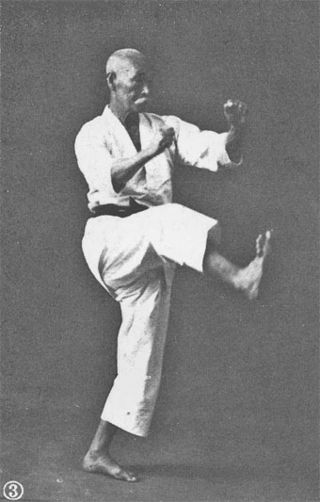
Karate (空手), also karate-do, is a martial art developed in the Ryukyu Kingdom. It developed from the indigenous Ryukyuan martial arts under the influence of Chinese martial arts. While modern karate is primarily a striking art that uses punches and kicks, traditional karate also employs throwing and joint locking techniques. A karate practitioner is called a karate-ka (空手家).

Keiko Fukuda was a Japanese-American martial artist. She was the highest-ranked female judoka in history, holding the rank of 9th dan from the Kodokan (2006), and 10th dan from USA Judo and from the United States Judo Federation (USJF), and was the last surviving student of Kanō Jigorō, founder of judo. She was a renowned pioneer of women's judo, and in 1972 together with her senpai Masako Noritomi (1913–1982) was one of the first two women promoted to 6th dan. In 2006, the Kodokan promoted Fukuda to 9th dan, making her the first woman to hold this rank from any recognized judo organization. She is also the first and, so far, only woman to have been promoted to 10th dan in judo, which occurred in 2011. After completing her formal education in Japan, Fukuda visited the United States to teach in the 1950s and 1960s, and eventually settled there. She continued to teach her art in the San Francisco Bay Area until her death in 2013.
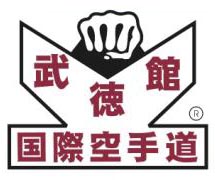
Gosoku-ryū (剛速流) is a style of karate which was founded by Takayuki Kubota. Gosoku stands for hard and fast, which suggests a combination of techniques both from the fast and dynamic Shōtōkan style as well as from the strength-focused Gōjū-ryū style.

Kata is a Japanese word meaning "form". It refers to a detailed choreographed pattern of martial arts movements. It can also be reviewed within groups and in unison when training. It is practiced in Japanese martial arts as a way to memorize and perfect the movements being executed. Korean martial arts with Japanese influence use the derived term hyeong and also the term pumsae.
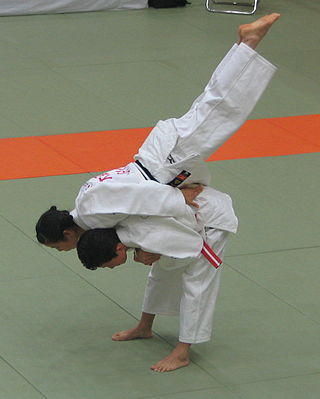
Ju no Kata is a kata in Judo. It is designed to teach the fundamental principles of judo, especially the principle of ju . It consists in three sets of techniques and is performed by a pair of people one acting as an Uke and the other a Tori. The kata can be performed without wearing a judogi and, as it doesn't involve the completion of any throws, does not need to be performed in a dojo.

Koshiki no Kata is a kata in Judo. It is also known as Kito-ryu no Kata (起倒流の形). It consists of 21 techniques originally belonging to the Takenaka-ha Kito School of jujutsu. Jigoro Kano revised the techniques and incorporated them into a kata in order to preserve the historical source of judo. The set of forms is antique and were intended for "Kumiuchi", the grappling of armored warriors in the feudal ages. As such, the kata is to be performed with both partners imagining that they are clad in armor. The Koshiki-no-kata, together with Nage-no-kata, Katame-no-kata, Ju-no-kata, Kime-no-kata and Goshin-Jitsu, is recognised by the International Judo Federation (IJF.) Although koshiki-no-kata is not often seen in the United States, it is still taught and practiced in Japan. Some striking demonstrations of it from the 1950s can be seen in the film "Classic Judo Kata," by Harold Sharp. If the description of the kata in that film is correct, it would be the only judo kata that involves attacking the cervical spine.
Fugakukai International Association, is an organization that promotes the teaching of the martial arts of Kihara aikido, Kodokan judo, and Shindo Muso-ryu jōdō. The name Fugakukai means literally "happy mountain peak association". Currently, Fugakukai dojo are located in the United States with one dojo in Canada.

Kanō Jigorō was a Japanese educator, athlete, and the founder of judo. Along with ju-jutsu, judo was one of the first Japanese martial arts to gain widespread international recognition, and the first to become an official Olympic sport. Pedagogical innovations attributed to Kanō include the use of black and white belts, and the introduction of dan ranking to show the relative ranking among members of a martial art style. Well-known mottoes attributed to Kanō include "maximum efficiency minimal effort" and "mutual welfare and benefit".
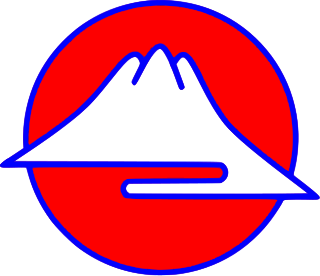
Yoseikan Aikido is the aikido taught at the Yoseikan Dojo in Shizuoka, Japan, under the direction of Minoru Mochizuki.
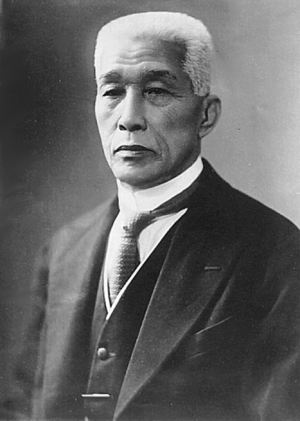
Yamashita Yoshitsugu, also known as Yamashita Yoshiaki, was a Japanese judoka. He was the first person to have been awarded 10th degree red belt (jūdan) rank in Kodokan judo, although posthumously. He was also one of the Four Guardians of the Kodokan, and a pioneer of judo in the United States.
Budokan is a style of karate recognized by the World Union of Karate Do Organizations and the World Karate Federation. Karate Budokan International was founded in 1966 by Chew Choo Soot in Petaling Jaya, Malaysia.

Mikinosuke Kawaishi was a Japanese master of jujutsu and judo who achieved the rank of 7th Dan. He led the development of Judo in France, with Shozo Awazu, and much of Europe and is credited with introducing the colored belt system for differentiating early grades. However, written accounts from the archives of London's Budokwai judo club, founded in 1918, record the use of colored judo belts at the 1926 9th annual Budokwai Display, and a list of ranked colored judokas appears in the Budokwai Committee Minutes of June 1927. Kawaishi visited London and the Budokwai in 1928, and was probably inspired to bring the colored belt system to France. The Fédération Française posthumously awarded him 10th Dan in judo and jujutsu.
The European Judo Championships is the Judo European Championship organized by the European Judo Union. The 2015 and 2019 editions were held during the respective European Games. This is also expected for future editions of the European Games.
The United States Judo Association is a sports association in the United States. It was formed in 1969 following a reorganization of the Armed Forces Judo Association, and is one of three national judo associations in the United States, the other two being USA Judo and the United States Judo Federation.
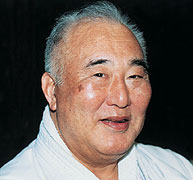
Taiji Kase was a Japanese master of Shotokan karate who was one of the earliest masters responsible for introducing this martial art into Europe. He taught his style of karate, Shotokan Ryu Kase Ha, in France from the late 1960s to the mid-1980s. In his later years, he travelled across the world teaching karate, but Paris remained his home. Kase held the rank of 9th dan in karate.
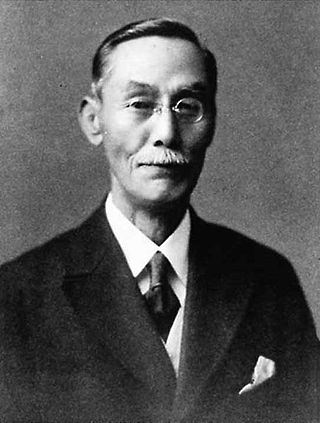
Tomita Tsunejirō, born Yamada Tsunejirō, was the earliest disciple of judo. His name appears in the first line of the enrollment book of the Kōdōkan. Tomita, together with Saigō Shirō, became the first in the history of judo to be awarded the rank of Shodan by the founder of judo, Kanō Jigorō, who established the ranking system that is now commonly used in various martial arts around the world. Tomita was known as one of the "Four Kings" of Kōdōkan judo for his victorious efforts in competing against jujitsu schools. He was awarded 7th dan upon his death on January 13, 1937.
Arthur Canario is a former nationally ranked judo practitioner and collegiate football player for Long Island University at CW Post. As an offensive tackle at LIU, he became an Academic All-American and graduated magna cum laude in 1973. He later attended the Georgetown University School of Medicine and became an orthopedic surgeon.
Nicolas Valcik is an American author, a higher education administrator, and Judoka. Valcik was previously the Managing Director of Institutional Research at Texas Tech University. Valcik has authored a series of notable case study books on strategic planning and analysis. His books have earned him various Taylor & Francis contracts.
Sadaki Nakabayashi is a former judo teacher and author. Nakabayashi authored a number of judo books including Judo, in 1968, How to Improve Your Judo in 1960, Fundamentals of judo in 1964. He also wrote the book fundamentals of Judo along with George Uchida and Olympic Coach Yoshihiro Uchida Nakabayshi taught for a period at the Kodokan. Nakabayashi is considered to be one of the best Judo instructors to have been sent to the United States.
References
- 1 2 "Obituary for Edward N. Szrejter at Boynton Memorial Chapel & Crematory". www.boyntonmemorial.com. Retrieved 18 February 2024.
- ↑ "From the executive director" (PDF). usja.net. December 1997. p. 3. Retrieved 18 February 2024.
- ↑ Jujutsu and Judo in the West: Uke Becomes Tori. Via Media. 24 April 2018. ISBN 9781717030153.
- ↑ Official A.A.U.-U.S.J.F. Judo Handbook. United States Judo Federation. 1968.
- ↑ "Young athletes shine brightly in judo competition".